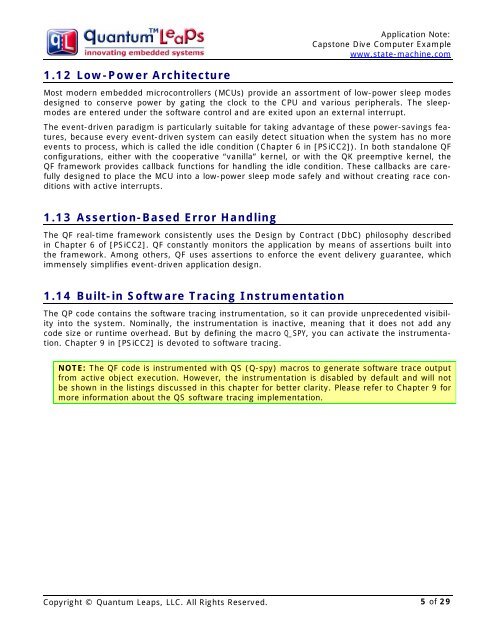AN: Capstone Dive Computer Example - Quantum Leaps
AN: Capstone Dive Computer Example - Quantum Leaps
AN: Capstone Dive Computer Example - Quantum Leaps
Create successful ePaper yourself
Turn your PDF publications into a flip-book with our unique Google optimized e-Paper software.
Application Note:<br />
<strong>Capstone</strong> <strong>Dive</strong> <strong>Computer</strong> <strong>Example</strong><br />
www.state-machine.com<br />
1.12 Low-Power Architecture<br />
Most modern embedded microcontrollers (MCUs) provide an assortment of low-power sleep modes<br />
designed to conserve power by gating the clock to the CPU and various peripherals. The sleepmodes<br />
are entered under the software control and are exited upon an external interrupt.<br />
The event-driven paradigm is particularly suitable for taking advantage of these power-savings features,<br />
because every event-driven system can easily detect situation when the system has no more<br />
events to process, which is called the idle condition (Chapter 6 in [PSiCC2]). In both standalone QF<br />
configurations, either with the cooperative “vanilla” kernel, or with the QK preemptive kernel, the<br />
QF framework provides callback functions for handling the idle condition. These callbacks are carefully<br />
designed to place the MCU into a low-power sleep mode safely and without creating race conditions<br />
with active interrupts.<br />
1.13 Assertion-Based Error Handling<br />
The QF real-time framework consistently uses the Design by Contract (DbC) philosophy described<br />
in Chapter 6 of [PSiCC2]. QF constantly monitors the application by means of assertions built into<br />
the framework. Among others, QF uses assertions to enforce the event delivery guarantee, which<br />
immensely simplifies event-driven application design.<br />
1.14 Built-in Software Tracing Instrumentation<br />
The QP code contains the software tracing instrumentation, so it can provide unprecedented visibility<br />
into the system. Nominally, the instrumentation is inactive, meaning that it does not add any<br />
code size or runtime overhead. But by defining the macro Q_SPY, you can activate the instrumentation.<br />
Chapter 9 in [PSiCC2] is devoted to software tracing.<br />
NOTE: The QF code is instrumented with QS (Q-spy) macros to generate software trace output<br />
from active object execution. However, the instrumentation is disabled by default and will not<br />
be shown in the listings discussed in this chapter for better clarity. Please refer to Chapter 9 for<br />
more information about the QS software tracing implementation.<br />
Copyright © <strong>Quantum</strong> <strong>Leaps</strong>, LLC. All Rights Reserved.<br />
5 of 29

















